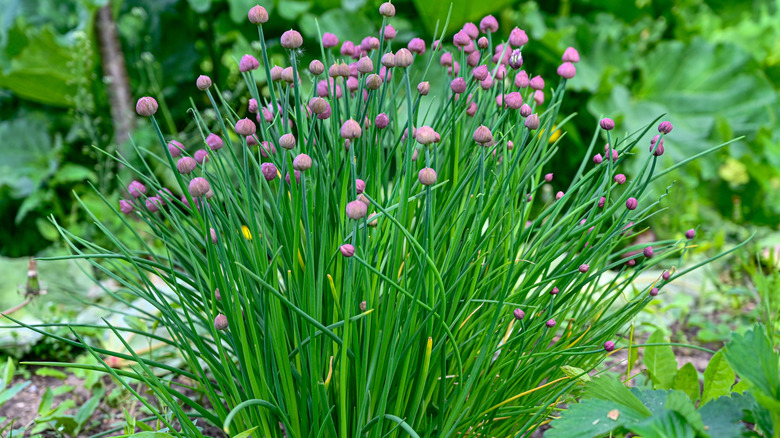The Easy-To-Grow Herb You Should Be Growing With Your Potatoes
Considered relatively easy to grow, potatoes (Solanum tuberosum) still require the right amount of water, nutrients, and maintenance in order to produce a healthy crop. While you might have researched some of the best ways to plant and grow potato plants, you should also consider adding other plants in your garden that might be helpful. Potatoes are among the many types of plants that can benefit from the concept of companion planting, which involves intentionally planting crops together that can help each grow successfully. Some examples include tomatoes and basil, strawberries and spinach, and lettuce and carrots. If you're looking to choose companion plants for your potatoes, there are a few herbs that may help. Chives (Allium schoenoprasum) are just one example of a good herb to plant near your potatoes, and they'll help in a couple of useful ways.
In particular, it's thought that chives can help protect potato plants from pests while also encouraging more pollinators to visit your garden. Chives require full sun and should be planted in well-draining soil. For easy mobility, you can keep chives in containers and place them near your potato plants, rather than planting them directly in the ground. If they do go in the ground, you can easily grow them from seed after the last frost, spaced between 6 and 12 inches apart. Chives can also be helpful companion plants for other garden crops, such as carrots and tomatoes. This easy-to-grow herb may even help cucumbers thrive in your garden. On the flipside, chives should not be planted next to peas and beans as onions (which chives are) can inhibit their growth.
Other tips for successful potato harvests in your home garden
Aside from companion planting with chives, there are other important steps you can take to help ensure potato growing success. First, avoid starting a new crop until after the last hard frost of the season. Depending on where you live, this could occur anywhere between mid-March and early May. It's also ideal to grow potato seeds from a certified supplier, rather than using seeds from old potatoes that might carry the risk of disease development. Once you have started your seed potatoes, place them with their buds facing upward about 4 to 5 inches deep into the soil. Each potato should also have 7 to 8 inches between them in rows of 2 to 3 feet apart.
Once you've started growing both your potatoes and chives, it is critical that you maintain a healthy soil. Potatoes require a soil pH of 4.8 to 5.4 to help prevent a bacterial disease known as potato scab. Also, once potato tops start growing out of the soil, you must hill the plants to prevent sun damage. This involves placing soil on top of the potatoes and around the bases of each of their plants. Take care to not allow the soil to dry out, but also do not over-water your potato plants. As a general rule, potatoes need about 1 inch of water weekly.

